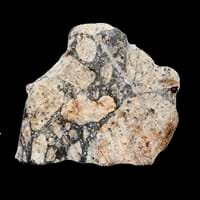Definition
Metapelite is an old and currently not widely used field geological term for a clay rich fine-grained clastic sediment or sedimentary rock, i.e. mud or a mudstone
Breccia is a rock consisting of angular fragments of stones which are cemented by finer calcareous material
Discoverer
Unknown
Unknown
Etymology
From Pelos or clay in Greek
From Italian, literally gravel, Germanic origin and related to break
Class
Metamorphic Rocks
Sedimentary Rocks
Sub-Class
Durable Rock, Medium Hardness Rock
Durable Rock, Hard Rock
Group
Not Applicable
Not Applicable
Other Categories
Coarse Grained Rock, Fine Grained Rock, Medium Grained Rock, Opaque Rock
Coarse Grained Rock, Medium Grained Rock, Opaque Rock
Texture
Foliated
Brecciated, Clastic
Color
Dark Greenish - Grey, Green, Light Green, Light Greenish Grey
Beige, Black, Blue, Brown, Buff, Green, Grey, Orange, Pink, Purple, Red, Rust, White, Yellow
Durability
Durable
Durable
Scratch Resistant
Yes
Yes
Appearance
Banded
Layered, Banded, Veined and Shiny
Interior Uses
Decorative Aggregates, Interior Decoration
Countertops, Decorative Aggregates, Entryways, Floor Tiles, Flooring, Homes, Hotels, Interior Decoration
Exterior Uses
As Building Stone, As Facing Stone
As Building Stone, As Facing Stone, Paving Stone, Garden Decoration, Office Buildings
Other Architectural Uses
Curbing
Curbing
Construction Industry
Cement Manufacture, Construction Aggregate, for Road Aggregate
As Dimension Stone, Construction Aggregate, Landscaping, Roadstone
Medical Industry
Not Yet Used
Not Yet Used
Antiquity Uses
Artifacts
Artifacts, Sculpture
Commercial Uses
Commemorative Tablets, Creating Artwork
Creating Artwork, Gemstone, Jewelry
Types
Not Available
Collapse Breccia, Fault Breccia, Flow Breccia, Pyroclastic Breccia, Igneous Breccia and Impact Breccia
Features
Easily splits into thin plates, It is One of the Oldest, Strongest and Hardest Rock
Available in Lots of Colors and Patterns, Clasts are smooth to touch
Archaeological Significance
Monuments
Not Yet Used
Not Yet Used
Famous Monuments
Not Applicable
Not Applicable
Sculpture
Not Yet Used
Used
Famous Sculptures
Not Applicable
Data Not Available
Pictographs
Used
Not Used
Petroglyphs
Used
Not Used
Figurines
Not Yet Used
Used
Formation
Due to change in environmental conditions, rocks are heated and pressurized deep inside the Earth's surface. Metapelite is formed from the extreme heat caused by magma or by the intense collisions and friction of tectonic plates.
Breccia is a clastic sedimentary rock which is composed of broken fragments of minerals or rock which are cemented together by a fine-grained matrix and it forms where broken, angular fragments of rock or mineral debris accumulate.
Mineral Content
Albite, Chlorite, Quartz
Calcite, Clay, Feldspar, Phosphates, Quartz, Silica
Compound Content
Aluminium Oxide, CaO, MgO
Aluminium Oxide, Ca, NaCl, CaO, Iron(III) Oxide, Potassium Oxide, Sodium Oxide, Silicon Dioxide, Titanium Dioxide
Types of Metamorphism
Not Applicable
Burial Metamorphism, Cataclastic Metamorphism
Types of Weathering
Biological Weathering, Chemical Weathering, Mechanical Weathering
Biological Weathering, Chemical Weathering, Mechanical Weathering
Types of Erosion
Chemical Erosion, Coastal Erosion, Water Erosion, Wind Erosion
Chemical Erosion
Grain Size
Medium to Fine Coarse Grained
Medium to Coarse Grained
Porosity
Highly Porous
Less Porous
Luster
Earthy
Dull to Pearly
Cleavage
Not Available
Non-Existent
Toughness
Not Available
Not Available
Specific Gravity
3.4-3.7
2.86-2.87
Transparency
Opaque
Opaque
Density
0-300 g/cm3
0 g/cm3
Specific Heat Capacity
Not Available
Resistance
Heat Resistant, Impact Resistant, Pressure Resistant
Heat Resistant, Impact Resistant, Pressure Resistant, Wear Resistant
Deposits in Eastern Continents
Asia
Not Yet Found
China, India, Kazakhstan, Mongolia, Russia, South Korea, Uzbekistan
Africa
Western Africa
Namibia, Nigeria, South Africa
Europe
United Kingdom
Austria, Denmark, Germany, Great Britain, Netherlands, Norway, Poland, Sweden, Switzerland, United Kingdom
Others
Not Yet Found
Greenland
Deposits in Western Continents
North America
Not Available
Barbados, Canada, Mexico, Panama, USA
South America
Brazil, Colombia, Ecuador
Brazil
Deposits in Oceania Continent
Australia
Central Australia, Western Australia
New South Wales, New Zealand
All about Metapelite and Breccia Properties
Know all about Metapelite and Breccia properties here. All properties of rocks are important as they define the type of rock and its application. Metapelite belongs to Metamorphic Rocks while Breccia belongs to Sedimentary Rocks.Texture of Metapelite is Foliated whereas that of Breccia is Brecciated, Clastic. Metapelite appears Banded and Breccia appears Layered, Banded, Veined and Shiny. The luster of Metapelite is earthy while that of Breccia is dull to pearly. Metapelite is available in dark greenish - grey, green, light green, light greenish grey colors whereas Breccia is available in beige, black, blue, brown, buff, green, grey, orange, pink, purple, red, rust, white, yellow colors. The commercial uses of Metapelite are commemorative tablets, creating artwork and that of Breccia are creating artwork, gemstone, jewelry.










